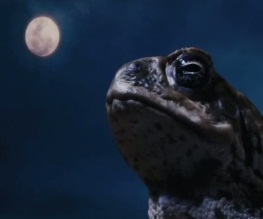Cane Toads 3D: The Conquest

Australia has, much to my surprise, become a vast battleground between human and toad. After being introduced into a small sugarcane field Down Under in an attempt to control the Greyback Cane Beetle, the Cane Toad quickly started an invasion on the Australian landscape. 102 toads became 1.5 billion, swiftly taking over 1,000,000 square kilometres of land. The amphibious beasts have occupied the nation’s consciousness for years, achieving a cult and criminal status which this tongue-in-cheek horror-documentary shamelessly exploits.
To begin with, we’re treated to archival footage which confirms the fact that the Cane Toad truly was loved by an entire nation. This Jabba The Hut lookalike was going to do wonderful things for the sugarcane farmers of Australia; a brave champion, rising up against a wave of destruction, welcomed by all. Sadly for them, the Cane Toad wasn’t all that bothered by the Greyback Cane Beetle and, instead, set its mind firmly on invading this vast new country. As Obi Wan would say: “You were the chosen one… You were to bring balance to the force, not leave it in darkness.”
Powerfully toxic, they are a danger to household pets (as we see from the dramatic E.R-esque account of Wilson the dog). They have a breeding cycle of 30 to 40000 eggs a year. And, strewth, are they ugly or what!? We know that something is up with these guys from the very beginning sequence, where we are submerged into a dark jungle amidst terrifying nighttime noises. The camera lands on a toad, which sits and stares at us, unblinking. And then, with a sudden gleam of malice, it charges the camera. It’s moments like these that make this documentary so easy to swallow; irreverent, witty and informative, it truly covers all bases.

“They have a funny smile on them, ” says one scientist fondly, looking at the camera. “They look innocent.” The interview-style allows for an array of opinions so diverse that it’s very difficult to believe we’re speaking about the same critter. Some folks love them so much that they’ve set up a travelling toad show or keep them as pets. Others, mainly in Queensland, are of the opinion that everybody should “just kill a toad” and, eventually, the species will be wiped out. The colourful and engaging characters we are introduced to each offer a unique perspective, whether it’s filling us in on the many methods of toad busting (trap em, gas em, strap em to rockets, freeze em, electrocute em, beat em with hockey sticks…) or filling us in on the “invasion army”.
Throughout the documentary, there are thousands of toads. Simply thousands. However, there is one everytoad who stops and watches the action unfold, whether in a lab, at parliament or in the great Bush itself. The combination of this voyeuristic amphibian with the well-selected music certainly adds a sense of drama to proceedings; whether our toad is grieving over the bodies of its slaughtered comrades or even plotting a murder (murder?!), it becomes as much of a character as any of the Sheilas or Bruces involved.

“You only need all the holes in the cheese to line up,” as one interviewee bafflingly says. I’m still unsure what this means, but I gather that it has something to do with the fact that humans have brought this on themselves. We have irretrievably altered our own ecosystem and, despite all the witticisms and amusing anecdotes, this documentary still holds a great degree of universal relevance. Sure, we can kill the toads, but all we’re doing there is finding a scapegoat and hammering it until we feel better about ourselves. Deep stuff.


Recent Comments